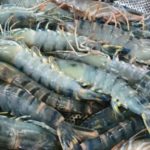When you go to the market, you will see shrimp in two different shapes, some are curved and some are straight. So, what is the difference between these two types of shrimp and which one is fresher?
Shrimp that are still swimming in the bucket look healthy. But when shrimp are placed on a tray, you need to pay attention to the straight-bodied ones. This is because when shrimp die, their muscles become loose, so they maintain their straight shape. Whereas when shrimp are still alive, their bodies will naturally curve.
The straight-bodied shrimp are usually the result of being frozen for a long time, so they taste bland and have a dull smell. On the other hand, when shrimp are still alive, they will curl up when touched.
In addition to the curved or straight shape, when choosing shrimp, you should pay attention to the following points:

If you see the head or tail is missing, do not buy it
When shrimp have been dead for a while, their heads and tails usually fall off, or they have been preserved with ice or preservatives for a long time. In general, when sellers have unsold inventory, they will use these shrimp to make processed shrimp. Therefore, when buying, you need to be especially careful. If the seller has already peeled the shell, you should observe the end point of the shrimp’s head. If the shrimp is not fresh, that end point will be soft, mushy, and peeled, indicating that it is from a shrimp that has lost its head.
This type of shrimp, when used to make processed shrimp, is usually sold at a low price but tastes bland. Shrimp is very nutritious, but when it spoils, the protein will turn into harmful toxins, so it is best to avoid this type of shrimp.
Avoid shrimp with red shells
Normal shrimp will have a red color when cooked. On the other hand, live shrimp will have a pearl, grayish color… If you see that the shrimp’s shell has turned red in some places, it indicates that the shrimp has been exposed to high temperatures, such as sunlight, and has not been properly chilled in ice. Therefore, the red shrimp shell does not retain its flavor. So, choose shrimp that have a consistent color and do not change color.

Avoid shrimp that feels soft
Good shrimp will have firm and solid flesh, which does not release water when cooked and tastes sweet. If you feel that the shrimp is soft, it indicates that it has spoiled or is a young shrimp. This type of shrimp tastes bland and fibrous when cooked and has a fishy smell, so stay away from it.
Look at the shape of the shrimp’s tail
Usually, shrimp that have not been injected with chemicals will have a tucked tail. But when they are injected with chemicals, their tails will spread out due to being stretched by the impurities injected into the shrimp. During the days leading up to the Lunar New Year, shrimp prices increase, so you need to be cautious to avoid the risk of traders injecting impurities into the shrimp to deceive and increase profitability. Shrimp injected with impurities not only taste bad but also have a high risk of bacterial contamination.
How to Choose Fresh Seafood: Important Cabinet Tips
In recent years, concerns have been raised over the practice of injecting urea and chemicals into seafood, making it difficult to find safe and fresh options. To help, DienmayXANH.com offers some tips on how to select the best seafood available. Seafood is a rich, delicious, and nutritious source of food, and this advice will help ensure you make the most of it.




































